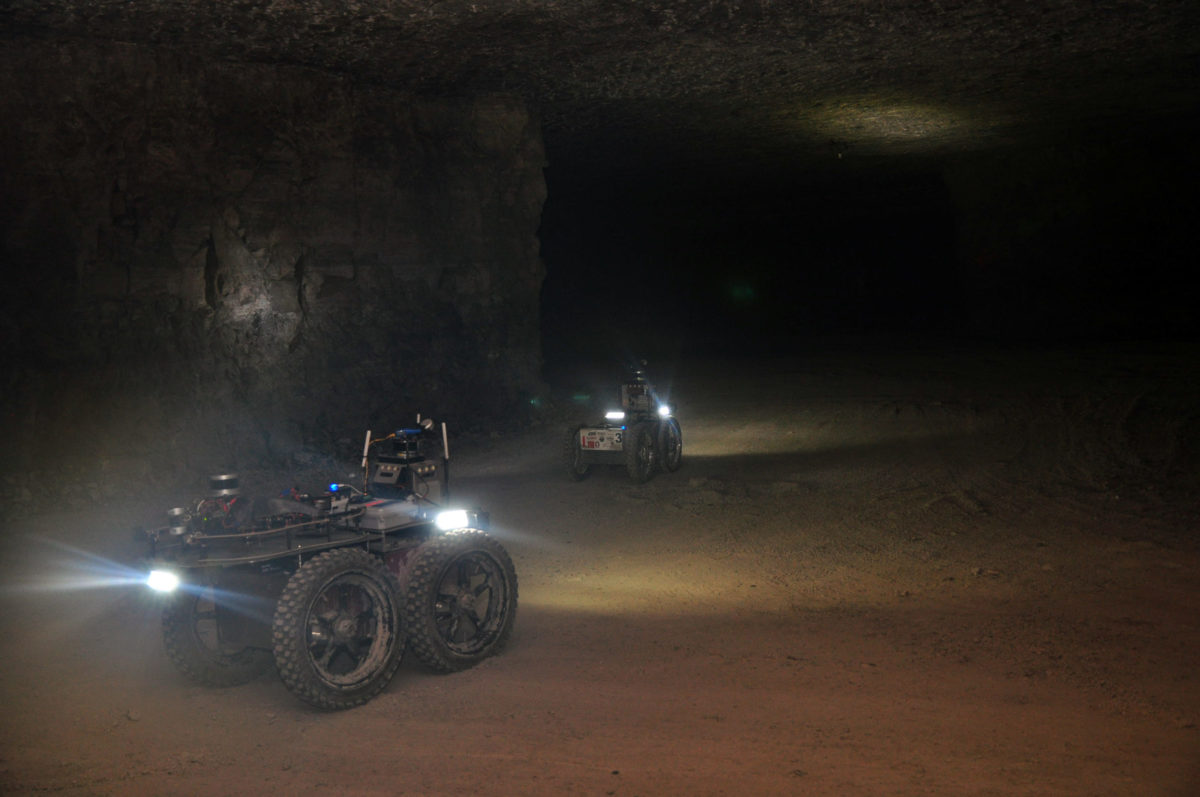Pittsburgh-made autonomous vehicles are going underground next week.
Carnegie Mellon University’s Team Explorer robots will be competing in the final event at the upcoming DARPA Subterranean Challenge, taking place on Sept. 21 to 24 at the Louisville Mega Cavern in Kentucky. DARPA is the Defense Advanced Research Projects Agency, aka the R&D agency of the U.S. Department of Defense.
Over the past three years, CMU and partner Oregon State University have been developing software and hardware components of robots to meet the object identification, mapping and navigation requirements of the challenge. The final competition involves using a fleet of robots to quickly traverse underground environments while also finding and identifying up to 40 objects that might be relevant to a real-world application of underground search and rescue missions. The first place team will win $2 million, with the second and third place earning $1 million and $500,000.
Check out this teaser video published by DARPA of the final round environment:
Team Explorer will go up against seven teams in the final cave round after winning first place in the tunnel circuit and second in the urban circuit. The team’s co-leads, Robotics Institute Associate Research Professor Sebastian Scherer and Robotics Institute Systems Scientist Matt Travers, said they plan to deploy seven or eight robots from a selection of ground rovers, large and small drones and walking robots into the cave for the 60-minute competition. While that might sound like a lot of robots for the one human operator allowed by the competition to handle, Scherer said that’s part of the challenge.

“So the robots have to be autonomous because a single operator can’t manually control that many robots. But if you don’t send in as many robots, you also don’t get the coverage,” he told Technical.ly during a Monday preview of the event, adding that part of the team’s strategy is to deploy different robots at different times and places as needed.
That operator will be Chao Cao, a second year Ph.D. student at the Robotics Institute, who’s been the planning lead for Team Explorer. Though he’ll be able to communicate with some team members during the competition, he’ll be the only one with access to real-time data from the robots and will be the final decision maker when it comes to deployment and operation strategy.
“It’s kind of like playing a video game,” said Cao. “Just like deploying your resources, and having them optimized to achieve your goals.”
But managing a fleet of robots alone can be arduous, especially if one loses communication: “That kind of really pushes us to develop a system where the robots can be reliably doing their own stuff without too much intervention,” he said of the robots’ autonomy.

Cao and the team have been readying for the competition by testing the robots at caves and mines around Pittsburgh, like Laurel Caverns in Farmington and Brady’s Bend Underground Storage in Armstrong County. The idea is to push the robots to their limits as much as possible before the competition, so that the team can learn from those challenges and improve the relevant functions to do better next time. That’s one of the things Cao likes most about robotics.
“We just go to the field, work with the robots, send them out and let them do their own thing, and then break them and then fix them,” he said.
Like many autonomous vehicle technologies, Scherer said, the robots are equipped with LiDAR scanners and several cameras — including a thermal one on-the-ground robots — as well as Wi-Fi and Bluetooth sensors to detect cell phones. The robots also have gas sensors that can detect the presence of carbon dioxide in different parts of the cave. Some of these sensor choices had to do with the requirements of the competition as outlined by DARPA, but each still has relevance to a real rescue mission for potential future applications of the robots.
Participation in DARPA competitions like this has a long legacy at CMU. The Tartan Racing team’s 2007 win in the Urban Challenge is now the stuff of legend among the autonomous vehicle industry, and is often referenced as the beginning of Pittsburgh’s prowess in that technology. That longtime community of autonomous vehicle expertise at CMU has propelled the advancements needed for competitions like the DARPA subterranean challenge.
“We start with a lot of strong components,” Scherer said of the university’s research community around this tech. “And then we build on top of them. And then we see their limitations. And then essentially, you research the next version.”
But a record of competition participation like this also helps CMU bring autonomous robotics research to real-world applications more easily, Dean of the School of Computer Science Martial Hebert said at Monday’s preview event. This work incorporates disciplines including sensor design, physical robot design, machine learning and autonomy.
“Research in all of those disciplines is critical work in progress,” he said. “But the thing that this kind of project shows is the importance of the secret sauce. The critical path to success is the integration of all of those disciplines, into systems that make a difference in the world.”
Those interested in watching the competition can find live coverage of the final round starting next Tuesday, Sept. 21, at noon on the competition’s SubTv.







